Energy systems
This research line focuses on the study, proposal and experimental and / or numerical verification of energy components and systems that present improvements in environmental, energy efficiency or economic impact with respect to the current state of technology. The research group has experience in projects in various topics, such as: thermal energy storage, absorption cooling, thermal solar collectors, life cycle analysis, distributed energy and energy audits in industry and buildings. The software we use includes a wide range of tools, ranging from 0-D tools for the study of energy systems such as EES, TRNSYS or Energy Plus to tools for detailed component analysis in 2-D or 3 -D, such as Comsol Multiphysics or CREO
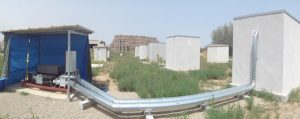

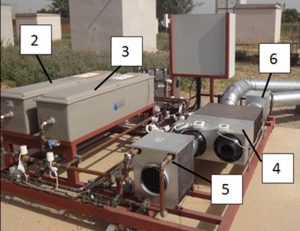
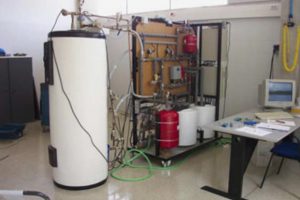
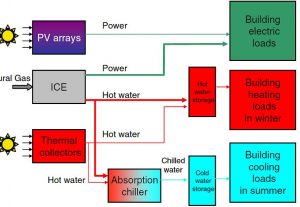
Currently the active lines of the group are the following:
- Development of mathematical models, potential maps and prototypes of radiative cooling devices and study of their technical feasibility.
- Study and development of next generation of renewable energy technologies based on high concentration solar systems.
- Development and spin-off creation of innovative solutions for advanced cooling of high heat flux in the field of microelectronic applications.
- Optimization of energy efficiency in buildings and industry with passive and active measures, such as: thermal insulation, thermal energy storage, renewable production of cold and heat, etc.
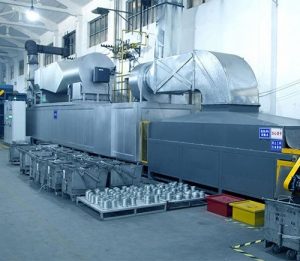
PROJECTS:
DEVELOPMENT AND EVALUATION OF A RADIATIVE COOLING AND SOLAR HEATING SYSTEM FOR COMBINED HEAT AND COLD PRODUCTION – RAD-CHC
Project RTI2018-097669-A-I00 funded by:

In the present project a new equipment, the Radiative Collector and Emitter (RCE), able to collect solar energy to produce heat and also able to produce cold by means of night radiative cooling will be developed and analysed. The project will prove the viability of the equipment and will determine its potential to produce cold and heat to be implemented in both buildings and industry. For such purpose, a new adaptive cover, capable to manage radiation with different wavelengths to allow solar collection during the day and radiative cooling during the night will be developed. The main innovation of the project is the development and demonstration of the new RCE equipment, since there exists no study that combines both capacities in a single equipment and the concept has not been proved. The behaviour of the new equipment will be experimentally tested and characterized and validated numerical models will be developed to simulate the equipment. By means of these models the effect of different improvements and optimizations in both the equipment and the whole system will be analysed. Afterwards, the capacity of the system to cover the cold and heat requirements for different applications previously selected will be determined, as well as new suitable applications will be identified. Finally, the technical, economic, and life cycle viability of the system will be studied.
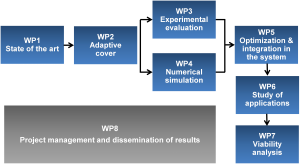
The benefits of the project are: (1) high scientific impact, developing a new equipment and opening a new research field; (2) high socioeconomic impact, contributing to fulfil the international environmental agreements, reducing the energy dependency of third countries, fostering the local industry, and creating new jobs.
Research team:
- Albert Castell
- Marc Medrano
- Ingrid Martorell
- Cristian Solé
- Lídia Rincón
- Andrea Salandin
- Sergi Vall
- Roger Vilà
- Ariadna Carrobé
DEVELOPMENT AND ANALYSIS OF A NEW DEVICE, THE ADAPTIVE RADIATIVE COLLECTOR AND EMITTER (AD-RCE), CAPABLE TO COLLECT SOLAR ENERGY DURING DAYTIME TO PRODUCE HEAT AND ALSO TO PRODUCE COLD BOTH DURING DAYTIME AND NIGHT-TIME BY MEANS OF RADIATIVE COOLING (ARES-DRC)
Project PID2021-126643OB-I00 funded by:

In the present project a new concept and equipment, the adaptive Radiative Collector and Emitter (ad-RCE), capable to collect solar energy during daytime to produce heat and also to produce cold both during daytime and night-time by means of radiative cooling will be developed and analysed. The new ad-RCE device combines both heat and cold production from renewable sources for buildings and industrial applications, adapting the heat and cold production to the demand profiles by its capacity to produce either heat or cold during daytime. The project will prove the viability of the equipment and will determine its potential to produce cold and heat to be implemented in both buildings and industry. For such purpose, newly developed daytime radiative cooling materials, which reflect almost all incident solar radiation while emitting thermal radiation to the outer space, will be used in combination with conventional solar collectors. The main innovation of the project is the development and demonstration of the new ad-RCE, since to date, there is no work that demonstrates this concept or develops a device capable to adapt its heat and cold production to the demand. The behaviour of the new equipment will be experimentally tested and characterized and validated numerical models will be developed to simulate the equipment. By means of these models the effect of different improvements and optimizations in both the equipment and the whole system will be analysed. Afterwards, the capacity of the system to adapt to the cold and heat requirements for different applications will be determined. Finally, the technical, economic, and life cycle viability of the system will be studied. The project is structured in different work packages:
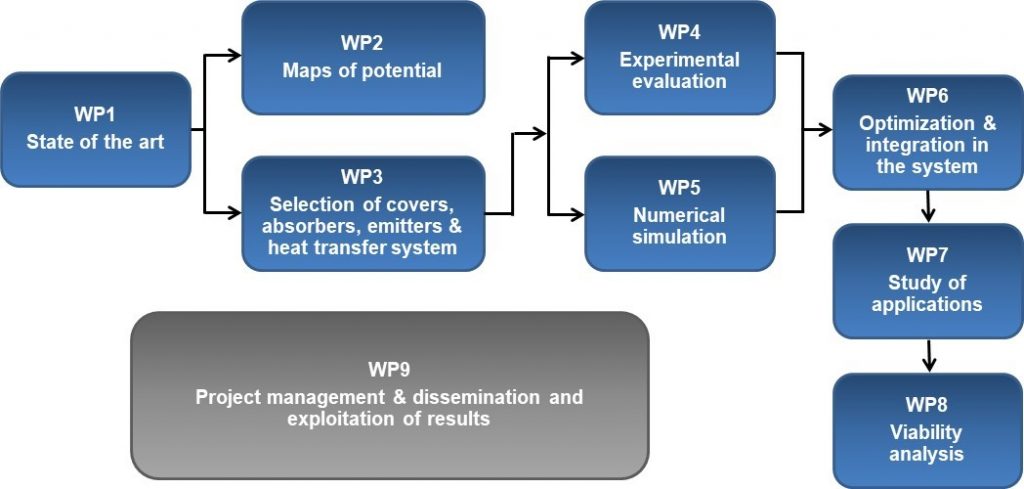
The benefits of the project are: (1) high scientific impact, developing a new equipment and opening a new research field; (2) high socioeconomic impact, addressing several SDG and contributing to fulfil the international environmental agreements, reducing the energy dependency of third countries, reducing energy poverty, fostering the local industry, and creating new jobs. The dissemination of results will be done in national and international conferences and workshops and in research papers of high impact. If promising results are obtained, a patent will be filed.
BOOSTING POWER OUTPUT IN A NEW RENEWABLE HEAT AND COLD SYSTEM BASED ON COMBINING RADIATIVE COOLING AND SOLAR HEATING (BOOST-RCE)
Project TED2021-131446B-I00 funded by:

In the project BOOST-RCE a new equipment capable to produce both heating and cooling in a single device, the Radiative Collector and Emitter (RCE), using renewable energy will be studied. This RCE collects solar energy to produce hot water during daytime and produces cold water under ambient temperature, by means of night-time radiative cooling (NRC), for buildings and industrial applications.
This proposal will contribute to solve several thematic areas of the European Green Deal such as increasing climate ambition; clean, affordable and secure energy; industry for a clean and circular economy; and energy and resource efficient buildings. The main objective of the project is to improve the power and energy production of cold water in the RCE device, proposed by the SEMB research group. This project builds upon the RAD-CHC (RTI2018-097669-A-I00) project, where the RCE concept was proved with promising results. However, one drawback of our RCE is that low cooling power densities below ambient temperatures are reached (average powers around 55 W/m2 and peaks around 70 W/m2 in the south of Europe), about an order of magnitude lower than those for heat. Thus, to increase the cold production of the RCE and put it as close as possible to the potential cooling powers presented in Spanish and European RC maps, an improvement of the RCE is required, both at device and full system levels.
The project is structured in six work packages:

The benefits of the project are: (1) high scientific impact with this unique equipment; (2) high socio-economic impact, addressing several SDG and contributing to fulfil the international environmental agreements and the ecologic transition. This project will contribute to reduce the energy dependency of third countries, to reduce energy poverty, to foster the local industry and to create new jobs. Results dissemination will be done in national and international conferences, workshops, and research papers of high impact.
PLUG AND PLAY RADIATIVE COLLECTOR AND EMITTER (PNP-RCE)
Project PDC2022-133215-I00 funded by:

The present project focuses on the further development and valorization of the Radiative Collector and Emitter (RCE) technology, which was developed in the RAD-CHC project (grant agreement RTI2018-097669-A-I00). The main objective of the present project is to develop and demonstrate under a relevant environment a Plug and Play RCE device which is robust, durable and reliable, and can be successfully integrated into an optimized installation. The RCE design must allow for long-term operation with low maintenance and sustained performance with time. The previous RAD-CHC project focused on the development and analysis of the new RCE concept, capable to collect solar energy to produce heat and to produce cold by means of night radiative cooling, in a unique device and in a renewable way. Thus, this new RCE device combines both solar collection for heat production and night-time radiative cooling for cold production for buildings and industrial applications. The RCE is able to produce in a renewable way Domestic Hot Water and cold (to support the cooling system), reducing the non-renewable energy consumption during the whole year, as well as the maximum installed power of the conventional production systems. During the RAD-CHC project, we demonstrated the RCE concept and its capability to produce hot water during the day and cold water (below room temperature) during the night, as well as its potential to cover different heat and cold demands for both conventional and nearly Zero Energy Buildings for different climates, as well as its suitability for different industrial processes. Its combination with conventional chillers/heat pumps was also studied, demonstrating the potential to improve their COP.
The RCE technology was developed to a TRL5 during the RAD-CHC project. The present project will allow bringing the technology to TRL6 Technology demonstrated in a relevant environment. For such purpose, some key aspects for market entrance must be addressed:(1) the development and validation of a robust, durable, and reliable Plug and Play RCE, (2) the optimization of the integration of the RCE with the whole HVAC installation, and (3) the identification of the most interesting market for the RCE initial deployment. Finally, the demonstration of the Plug and Play RCE in a relevant environment will be performed to check that test results indicate engineering feasibility. The project will allow a step further in the technology transfer and exploitation of this new technology. Results will be disseminated to the society as well as to key industrial stakeholders to allow faster development and future demonstration projects.
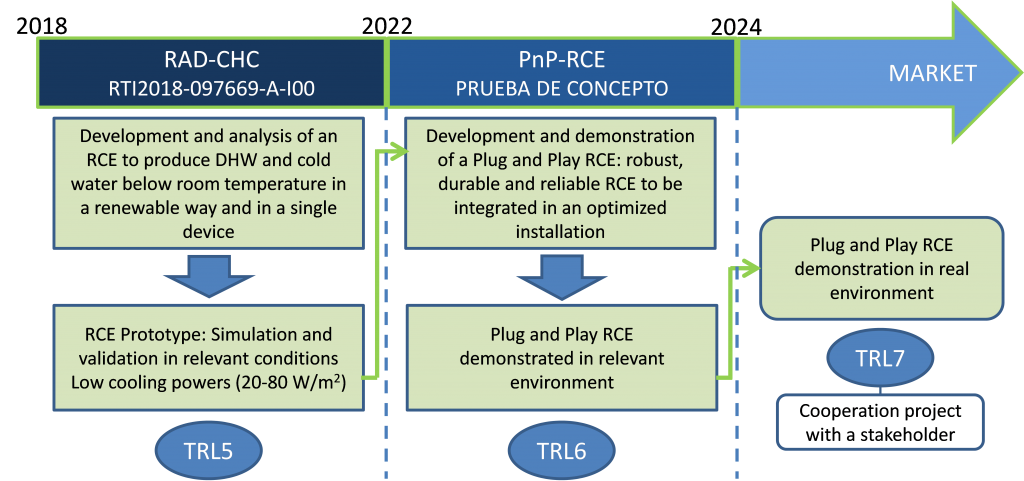
Foreseen benefits from the project are high socio-economic impact, addressing several Sustainable Development Goals (SDG) and contributing to fulfilling the international environmental agreements, reducing the energy dependency of third countries, reducing energy poverty, fostering the local industry, and creating new jobs.
COOLHEAT-INDUSTRY: PREINDUSTRIAL PROOF-OF-CONCEPT OF RCE IN FOOD INDUSTRIES
Project 2024 PROD 00040 funded by:

The COOLHEAT-Industry project introduces an innovative concept, the Radiative Collector and Emitter (RCE), a renewable technology that produces CO2-free heat and cold 24 hours a day through solar collection and radiative cooling, respectively. This technology can be integrated with conventional heating and cooling systems to enhance efficiency and reduce both energy consumption and CO2 emissions.
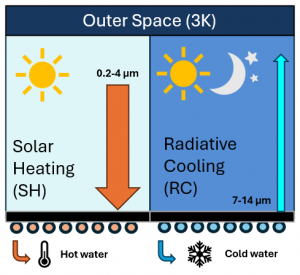
The food industry, one of the most challenging sectors to decarbonize, heavily relies on traditional technologies that consume significant amounts of electricity and fossil fuels for their heating and cooling needs. The main objective of the COOLHEAT-Industry project is to develop a preindustrial proof-of-concept specifically applied to the food industry, to validate and refine the turnkey business model of the RCE technology, ensuring it meets the industry’s needs effectively.
COOLHEAT-Industry aims to contribute to the decarbonization of the food industry by providing energy savings of between 20% and 60% in processes requiring both heat and cold, leading to substantial economic savings and a reduced carbon footprint. By supporting the energy transition, the RCE technology will contribute to achieving the United Nations Sustainable Development Goals (SDGs), particularly SDG 7 (Affordable and Clean Energy), SDG 9 (Industry, Innovation, and Infrastructure), SDG 11 (Sustainable Cities and Communities), and SDG 13 (Climate Action). This shift towards greener technologies will not only help mitigate climate change but also enhance the competitiveness of the food industry by reducing operational costs and dependency on non-renewable resources.